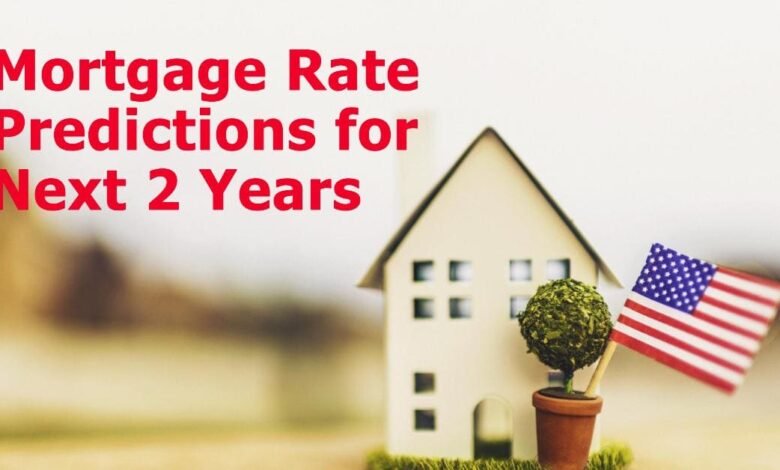Mortgage Rate Predictions for Next 2 Years

As of April 19, 2024, the mortgage landscape in the United States has been marked by a period of fluctuation, with rates experiencing a slight increase. Here’s an analysis of current averages and expert predictions for the next two years. The average rate for a conventional 30-year fixed mortgage was reported at 7.22%, while the 15-year fixed mortgage stood at 6.657%. These figures represent a snapshot of the current state of the mortgage market, which is influenced by a myriad of economic factors, including inflation, Federal Reserve policies, and the global financial climate.
- 30-year fixed: This enduringly popular option sits around 7.25%, reflecting a modest increase from the previous month. This aligns with broader economic trends.
- 15-year fixed: For those prioritizing a faster payoff, the average rate is a more attractive 6.45%.
- 5/1 adjustable-rate mortgage (ARM): If your timeline for homeownership is shorter (think 5-7 years), ARMs with a lower introductory rate might be tempting. The current average on these is 7.72%.
Expert Mortgage Rate Predictions for Next Two Years (2024-2026):
Most experts expect rates to remain elevated for the foreseeable future, with a possibility of some decrease.
- Freddie Mac: Their forecast sees rates remaining above 6.5% at least through the second quarter of 2024.
- Fannie Mae: Their revised outlook anticipates a 30-year fixed rate reaching 6.4% by year-end, slightly higher than their previous estimates.
- National Association of Realtors: Chief economist Lawrence Yun suggests rates will likely hover between 6% and 7% for most of 2024. He cites factors like inflation and the budget deficit as contributing influences.
Looking ahead, the predictions for mortgage rates over the next two years suggest a gradual decline. Experts from various financial institutions and housing associations have weighed in, providing a consensus that, while the rates may not see a dramatic drop, there is an expectation of a downward trend.
The Mortgage Bankers Association (MBA) forecasts that the 30-year fixed-rate mortgage will end 2024 at 6.1% and reach 5.5% by the end of 2025. This aligns with the sentiment from other industry analysts, who anticipate that the Federal Reserve’s potential rate cuts could ease the mortgage rates slightly.
The National Association of Realtors echoes this outlook, projecting that mortgage rates will average around 6.8% in the first quarter of 2024, with a gradual decrease to 6.1% by the year’s end. Similarly, Fannie Mae’s mortgage rate forecast suggests that the 30-year mortgage rate will end in 2024 at 6.4%, up from a previous forecast of 5.9%. These projections are subject to change as they are contingent upon various economic indicators and policy decisions that could alter the course of the mortgage rate trajectory.
Factors Influencing Mortgage Rates Over the Next 2 Years
As we look toward the next two years, several key factors are poised to influence the direction of mortgage rates in the United States.
- Federal Reserve Policies: The Federal Reserve’s monetary policy is a primary driver of mortgage rates. Decisions on interest rates, influenced by economic data and inflation targets, directly impact the cost of borrowing. The Fed’s signaled interest rate cuts could lead to a decrease in mortgage rates, fostering a more favorable borrowing environment.
- Inflation: Inflation remains one of the most significant factors affecting mortgage rates. Efforts to curb inflation could result in adjustments to interest rates, with higher inflation typically leading to higher mortgage rates to counteract the economy’s overheating.
- Economic Growth: The overall health of the economy plays a crucial role. Strong economic indicators might push rates up as demand for credit increases, while signs of a slowdown could lead to decreases in an effort to stimulate borrowing and investment.
- Housing Market Dynamics: The balance of supply and demand in the housing market will also impact rates. A surplus of homes could lead to lower rates to encourage buying, whereas a shortage might drive rates up as competition for available homes increases.
- Global Events: International events, such as geopolitical conflicts or global economic downturns, can affect investor confidence and lead to fluctuations in mortgage rates as investors seek safer assets like U.S. Treasury bonds, influencing yields and borrowing costs.
- Government Policies: Fiscal policies, including tax laws and housing regulations, can influence mortgage rates. For example, policies that stimulate housing construction can increase supply, potentially leading to lower mortgage rates.
- Consumer Behavior: The demand for mortgages is also shaped by consumer confidence and demographic trends. Changes in homebuyer preferences or shifts in population growth can affect the demand for mortgages and, consequently, the rates.
- Bond Market Movements: Mortgage rates are closely tied to the bond market, particularly the 10-year Treasury yield. As investors’ perceptions of risk change, so do bond yields, which can lead to corresponding changes in mortgage rates.
- Banking Sector Health: The financial stability and lending practices of banks can influence mortgage rates. A robust banking sector may offer more competitive rates, while a struggling one might tighten lending and increase rates.
- Technological Advancements: The rise of fintech and online lending platforms has introduced more competition into the mortgage industry, which could lead to more favorable rates for consumers as companies vie for business.
Summary: Experts from various financial institutions and housing associations have weighed in, providing a consensus that, while the rates may not see a dramatic drop, there is an expectation of a downward trend in the next two years. While forecasts can provide a general direction, the actual rates will depend on how these factors evolve.





